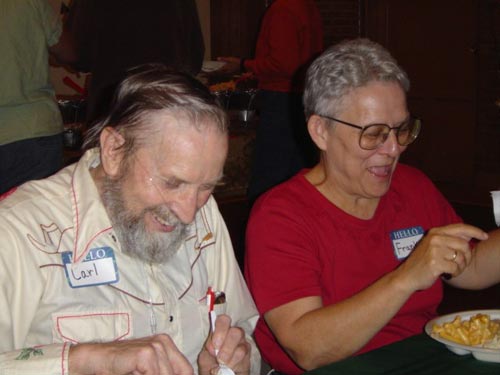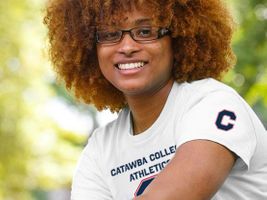Dr. Maria Vandergriff-Avery can’t wait to take her students to Floyd – Floyd, Virginia that is. And there, at the Floyd Country Store, they’ll gather with local residents, farmers, tourists, yuppies, academics, artists and business men and women to witness the Friday Night Jamboree, some of the best impromptu bluegrass music in the country and some authentic flat foot dancing. After the experience, she’s hopeful they’ll have a truer and deeper understanding of Appalachian people and their culture.
 This assistant professor of sociology at Catawba College will be retracing many of her own footsteps when she and her colleague, Dr. Philip Acree Cavalier, take the students in their honors course on a four-day sojourn over fall break. One of the goals of the course they are team teaching, “Imperialism Within: Appalachian Culture and Society,” is to give the students a true, well-rounded picture of southern Appalachia.
This assistant professor of sociology at Catawba College will be retracing many of her own footsteps when she and her colleague, Dr. Philip Acree Cavalier, take the students in their honors course on a four-day sojourn over fall break. One of the goals of the course they are team teaching, “Imperialism Within: Appalachian Culture and Society,” is to give the students a true, well-rounded picture of southern Appalachia.
“In the national imagination, Appalachia often stands for backwardness, poverty, and ignorance,” the course syllabus reads. “During the semester, we will challenge the stereotypes associated with southern Appalachia, explore the rich cultures and societies that have emerged throughout the region, and address the tension between outsiders who define Appalachia and the region’s inhabitants who identify themselves very differently.”
 Vandergriff-Avery, herself a descendant of East Tennessee mountain people, honed her own professional knowledge of the region this past summer as a participant in a National Endowment for the Humanities Institute. She came away with vibrant and sometimes dichotomous images of a land and a people ill used, misunderstood, yet surviving and often thriving.
Vandergriff-Avery, herself a descendant of East Tennessee mountain people, honed her own professional knowledge of the region this past summer as a participant in a National Endowment for the Humanities Institute. She came away with vibrant and sometimes dichotomous images of a land and a people ill used, misunderstood, yet surviving and often thriving.
“Not one image is representative of the entire region,” she explains, noting that many different images define it. There is the image of the strong, independent female as entrepreneur -- Orby, running her coffee shop in War, W. Va.; the image of a strong female activist, fighting for the people in her mountainside hometown of Caretta, W. Va. – Franki, the director of Big Creek People in Action; the image of both yuppies and local Appalachia residents gathering at a general store in the tiny town of Floyd, Va. on a Friday night to listen and dance to bluegrass music; and the image of a beautiful tree-covered mountainside rising in the distance and in the foreground of the valley town of Caretta, the rusting remains of abandoned coal mining equipment.
 “We create this ‘other’ so we can feel better about ourselves, and the people of southern Appalachia do the same,” Vandergriff-Avery recalls. “We define the ‘other’ as ‘backwards’ or ‘needing our help’ or ‘married to a relative,’ but that’s not ‘us.’ ”
“We create this ‘other’ so we can feel better about ourselves, and the people of southern Appalachia do the same,” Vandergriff-Avery recalls. “We define the ‘other’ as ‘backwards’ or ‘needing our help’ or ‘married to a relative,’ but that’s not ‘us.’ ”
Tourism, she knows, is the new industry of the region, replacing the historic economic roots in coal mining and timber. And even though the local residents of the region depend on those visiting and passing through for their livelihoods, Vandergriff-Avery says there is “an ongoing tension between insiders and outsiders.”
McDowell County, W. Va., where Caretta is located, is the sixth poorest county in the United States, but residents there are doing their fighting best to change that, Vandergriff-Avery learned. She and other participants in the NEH institute witnessed those local efforts when they spent six days in the town, housed barracks-style in a former school building which is also the office of Big Creek People in Action.
“Big Creek People in Action is a grassroots organization devoted to improving the community,” she explains. “McDowell County was thriving in the early 20th century and called a little NewYork. It had a very diverse community because of all of the ethnic groups who moved there to work.
“Today, Caretta is an old coal mining town and a lot of the old coal mining equipment is just sitting there, rusting out. Eighty-five percent of the land in this town's county is owned by absentee owners who don’t care what the equipment looks like. While it stays in place, it creates a powerful image of a land forgotten.”
Vandergriff-Avery recalls Franki telling her that McDowell County had kept its contract with America to produce coal to run U.S. steel companies, but America has not kept its contract with McDowell County to improve the lives of its residents. So, Big Creek People in Action is taking matters into its own hands, organizing computer classes and general education degree courses to improve the plight of those who remain in the county after the old industries have dried up, and fixing up once-used buildings, like the old school building for new community uses.
Fifteen minutes away from Caretta in Coalwood, W. Va., a one-time model coal-mining town, Vandergriff-Avery met Franki’s antithesis, a local woman who mourned the departure of the coal mining industry. “She was very positive about what the coal companies had brought there and wished they would come back,” Vandergriff-Avery notes, adding that ironically, there was no leftover mining equipment to rust out in this town.
But except for the tourists, who visit the southern Appalachia region for recreation, there are more departures nowadays than arrivals. Vandergriff- Avery calls it a “brain drain” on the region, wherein the best and brightest students finish high school, go off to college, and never come back. And those who take their leave from the region are the very ones Franki and her group seek to retain and attract, hence her organization’s mission: “To foster a community in which people learn, work, play and grow together and prepare themselves for success in the 21st century.”
The mission of the Big Creek People in Action is a daunting one considering that McDowell County, with a population of only 25,000 people has these attributes to tout: the fifth highest child poverty rate in the U.S.; a median family income of half the national average; the lowest levels of educational achievement in the U.S.; the highest illiteracy rate in adults in West Virginia; and only 3.4 percent of its workforce with college degrees.
But that mission is one that Vandergriff-Avery and Acree Cavalier hope their students are able to perceive even during their brief visit to Appalachia.
